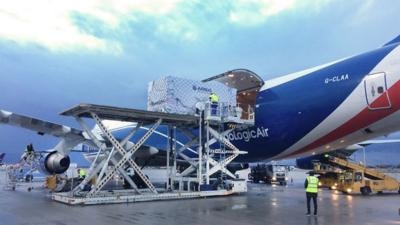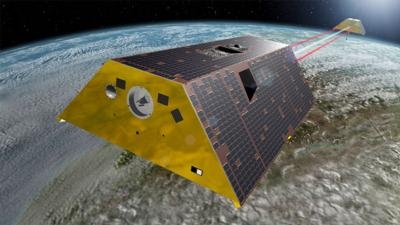Sat, Dec 16, 2017
German-Built Gravity Research Spacecraft Are On The Way To Vandenberg Air Force Base In California
The twin GRACE-FO satellites have begun their journey to Vandenberg Air Force Base in California. Together with test equipment totalling around 50 tons, the gravity research satellites built and developed by Airbus in Friedrichshafen (Germany) were loaded overnight onto an air freighter at Munich airport and flown to the U.S. Tuesday. GRACE-FO is a joint project between NASA’s Jet Propulsion Laboratory (JPL) based in Pasadena, California, and the German Research Center for Geosciences (GFZ) in Potsdam.

Both GRACE-FO research satellites are scheduled for launch in spring 2018, and will be placed in a polar orbit of around 310 miles and with a distance of 136 miles between them. The mission is planned to last at least five years. The satellites will constantly measure the distance between each other to within a few microns using a microwave system built at JPL. At the same time, a sensitive accelerometer, built at Onera in France, will account for non-gravitational effects, such as atmospheric drag and solar radiation.

The data will be used to track the movement of liquid water, ice and land masses by creating monthly maps of the changes in Earth’s gravitational field. GRACE-FO continues this essential climate record established by the predecessor GRACE mission, a joint project between the United States and Germany. GRACE ended its science operations in October after more than 15 years of operations.
The GRACE-FO satellites will also feature a new inter-satellite laser ranging instrument, developed in a German/American joint venture, which will be tested for use in future generations of satellites. In addition, each satellite will record up to 200 profiles per day of temperature distribution and water-vapour content in the atmosphere and the ionosphere to aid weather forecasting.
A team of 15 Airbus space engineers and technicians are currently awaiting the arrival of the satellites in California. The plan is to assemble all test systems on site and check the GRACE-FO spacecraft before the Christmas break in readiness for the launch campaign in 2018.
(Images provided with Airbus news release)
More News
From 2023 (YouTube Version): Legacy of a Titan Robert (Bob) Anderson Hoover was a fighter pilot, test pilot, flight instructor, and air show superstar. More so, Bob Hoover was an i>[...]
Get The Latest in Aviation News NOW on Instagram Are you on Instagram yet? It's been around for a few years, quietly picking up traction mostly thanks to everybody's new obsession >[...]
Aero Linx: B-52H Stratofortress The B-52H Stratofortress is a long-range, heavy bomber that can perform a variety of missions. The bomber is capable of flying at high subsonic spee>[...]
Altimeter Setting The barometric pressure reading used to adjust a pressure altimeter for variations in existing atmospheric pressure or to the standard altimeter setting (29.92).>[...]
"Knowing that we play an active part in bettering people's lives is extremely rewarding. My team and I are very thankful for the opportunity to be here and to help in any way we ca>[...]
 Classic Aero-TV: Remembering Bob Hoover
Classic Aero-TV: Remembering Bob Hoover ANN FAQ: Follow Us On Instagram!
ANN FAQ: Follow Us On Instagram! ANN's Daily Aero-Linx (05.15.24)
ANN's Daily Aero-Linx (05.15.24) ANN's Daily Aero-Term (05.15.24):Altimeter Setting
ANN's Daily Aero-Term (05.15.24):Altimeter Setting Aero-News: Quote of the Day (05.16.24)
Aero-News: Quote of the Day (05.16.24)




